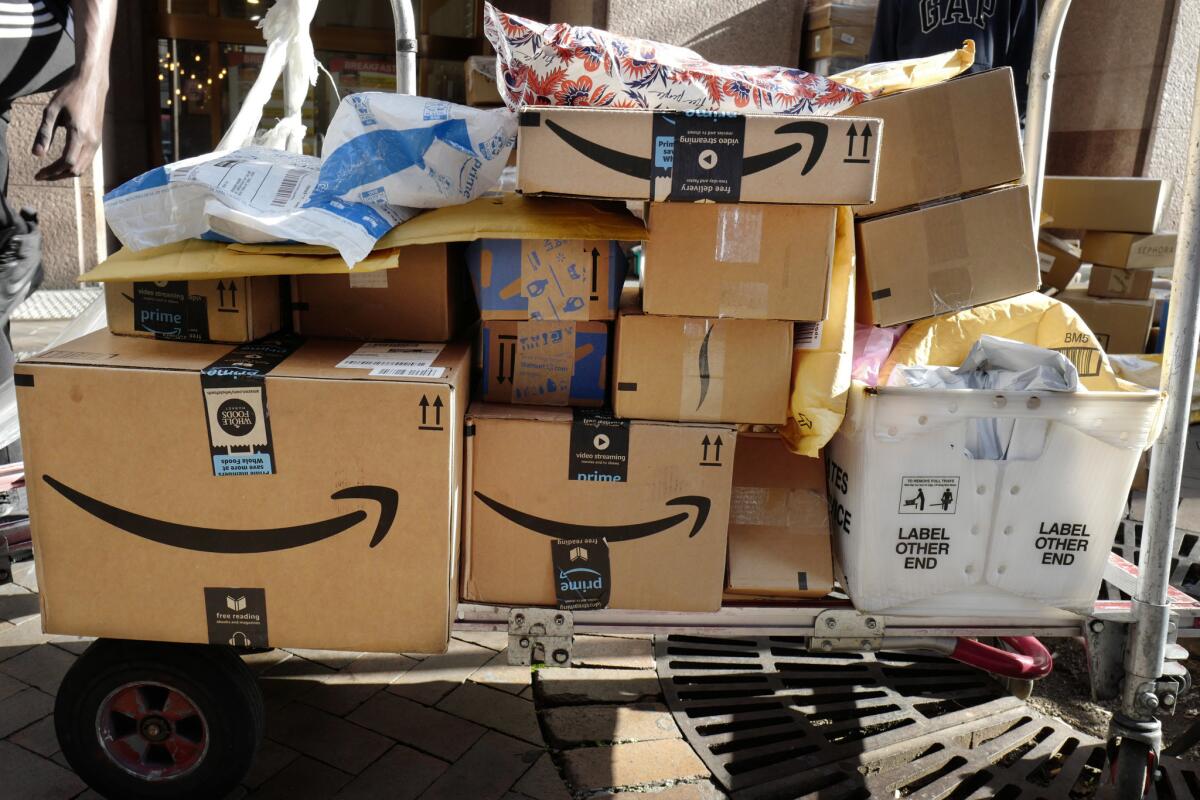Amazon taught us to rely on fast delivery. In coronavirus era, it can’t keep up

- Share via
Jesse Rodriguez just wanted his weekly batch of groceries. And because his asthma makes the coronavirus pandemic especially dangerous for him, he didn’t want to mix with the crowds at a supermarket.
No big deal, the 59-year-old West L.A. legal assistant thought last Thursday — he’d use Amazon Prime.
But the service was swamped. It had no delivery times available for days, he recalled. So he tried shopping service Instacart, only to find that most items he wanted were out of stock. He ended up going to a market after all, gobsmacked by the unavailability of systems that have become so ingrained in everyday life.
“As Americans, we do get used to certain things,” Rodriguez said. “When it’s just nonexistent, it’s alarming.”
Amazon.com Inc. and other major retailers have spent years teaching Americans to order online and expect same-day or one-day deliveries. Now that the coronavirus outbreak has pushed people nationwide into their homes and away from crowds, online orders have surged, and the companies can’t keep up.
“Online usage has gone through the roof,” said Brent Thill, an analyst with the investment firm Jefferies. “No one wants to go into a store, so the pressure on the e-commerce vendors is like nothing we’ve seen before. Your delivery wait times are going to be longer.”
At the top of the homepage of Amazon’s grocery site, which includes its Amazon Fresh and Whole Foods Market units, there’s a warning: “Inventory and delivery may be temporarily unavailable due to increased demand. Confirm availability at checkout.”
Deliveries from Walmart.com, Target.com and other retailers also have slowed, and some customers are being mistakenly told that orders are being filled when in fact products are out of stock. Walmart’s homepage carries the notice that “NextDay delivery currently unavailable.”
Amazon accounts for 38% of all U.S. online retail sales, according to research firm EMarketer. More than 150 million people worldwide pay for an Amazon Prime membership ($119 a year, or $59 a year for students), which includes same-day or one-day delivery, but that benefit is being overwhelmed by the disruption, analysts said.
Amazon also said this week that it’s prioritizing shipments of medical supplies, household staples and other products that are in high demand due to the pandemic. Items deemed nonessential will have to wait.
The e-commerce giant told third-party merchants that use its platform — and that account for about 58% of all goods sold on its site — that it would stop accepting their shipments to its warehouses if their products weren’t on that priority list, at least through April 5.
Those merchants can still sell on Amazon but would be responsible for storing and shipping the goods themselves, a task for which many aren’t equipped. The result: Customers ordering certain electronics, toys, apparel and other goods on Amazon are looking at deliveries that could take days or more, even if those items already are sitting in Amazon’s warehouses.
“Even deliveries from Amazon Prime are not being delivered anywhere close to one or two days because not only is Amazon overwhelmed, but UPS, FedEx and all the last-mile delivery companies also are overwhelmed,” said Juozas Kaziukenas, founder of the research firm Marketplace Pulse.
“The whole supply chain in the country is being pushed to the limit because no one was expecting such an explosion of demand in the first quarter, because it never happens,” Kaziukenas said.
Harrison Bryant, 23, a nanny in Riverside, said she placed an order for cold medicine, household cleaners and food on Target.com to be picked up at her local Target store the next day.
But when she arrived, “our order was nowhere to be found,” Bryant said. “Everything we had ordered was completely out of stock even though the website had said our order was fulfilled.
“It was incredibly frustrating,” Bryant said, because she lives with her parents and “I worry about them with the coronavirus. We ordered cold medicine and we weren’t able to get that. If they were to come down with anything, I’d like to know that we had something in our house that could keep them at least mildly protected and were couldn’t get that, either.”
Amazon, Walmart and Target did not respond to requests for comment. A note on Target’s website said that the chain was “working to fulfill online orders and staffing up services” but that “due to high demand, we are facing delays.”
Amazon said this week that it’s was hiring an additional 100,000 U.S. employees to meet “the surge in demand from people relying on Amazon’s service during this stressful time.”
The Seattle company also said it was raising its U.S. hourly workers’ pay by $2 an hour through April from its current rate of $15 an hour or more, depending on the region, as they handle the onslaught of orders.
“We are seeing a significant increase in demand, which means our labor needs are unprecedented for this time of year,” Amazon said in a blog post. “Getting a priority item to your doorstep is vital as communities practice social distancing, particularly for the elderly and others with underlying health issues.”
Early this month, EMarketer forecast that Amazon would sell $404 billion worth of goods this year, a 17% jump from 2019, in good part because its same-day and one-day shipping option was fueling added growth. That was before the coronavirus crisis took hold. EMarketer said its forecast will be revised.
Amazon, which earned $11.6 billion on revenue of $281 billion last year, “will take a financial hit, no question” because its “costs are going higher and what they can sell now goes lower” in volume as Amazon prioritizes selling virus-related goods, Thill said.
But Thill said Amazon was responding to how “consumers are shifting their behavior” during the crisis.
“I don’t think orders of TVs and computers and other nonessential items are among consumers’ top budget items right now,” he said. “It’s more about ‘How do I get toilet paper and household items to live my life?’”
At the same time, the public understands how the virus has caused unprecedented disruption and will forgive the retailers for delays, said Andrew Lipsman, retail analyst at EMarketer.
“It doesn’t mean consumers won’t be frustrated by the delays, but I think there’s a general recognition that the supply chain is strained and will impact delivery times,” Lipsman said. “I don’t think people are going to be angry about this.”
Walmart also has seen a surge in grocery orders because people are stuck at home or reluctant to visit physical stores, including supermarket chains that have cut back their hours to restock and disinfect.
“Walmart’s online grocery is absolutely killing it right now,” Kaziukenas said, adding that Walmart’s grocery app was one of the most downloaded apps on Apple’s iPhone app store this week.
“Online groceries are mostly coming from the stores, and because Walmart has so many stores, it gives them much wider coverage,” Kaziukenas said. Walmart has more than 4,000 supercenters and neighborhood markets in the United States, and orders can be picked up at the stores or delivered.
Many Americans are ordering groceries online for the first time due to the virus, and a significant number likely will keep doing so after the outbreak subsides, Lipsman said.
“This will lock in new behavior,” he said. “You’re going to see a meaningful percentage of consumer grocery orders permanently shift to digital channels, either to be picked up at the store or delivered to your home.”
More to Read
Inside the business of entertainment
The Wide Shot brings you news, analysis and insights on everything from streaming wars to production — and what it all means for the future.
You may occasionally receive promotional content from the Los Angeles Times.












